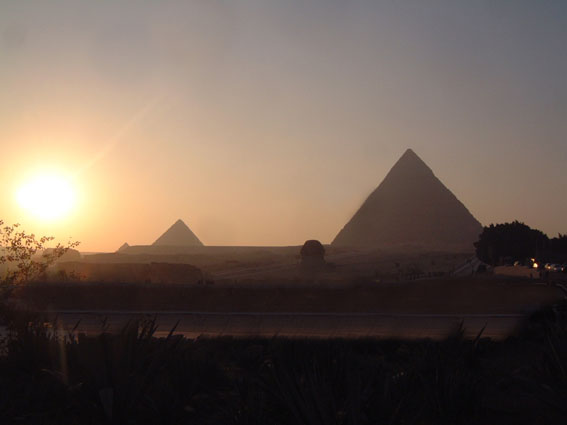
Sunset
at Giza (pic credit: Andrew Collins)
O
R I O N: THE ETERNAL RISE
OF THE SKY HUNTER
Andrew Collins explores the role of Orion in the human mindset, from its first appearance in the carved art of the Upper Palaeolithic age through to its place in the Orion Correlation Theory. This includes its role in the re-dating of the Great Sphinx and fixing the date for zep tepi, the age of the gods in ancient Egypt. He examines the stellar significance of the Great Pyramid's four air shafts, and looks at the dual role Orion and Cygnus played both in ancient Egypt, and within the afterlife cosmology of North America's Southeastern Ceremonial Complex (SECC).Finally, he asks whether the Giza Pyramids were positioned to reflect the astronomical positions of the "belt" stars of Orion or the "wing" stars of Cygnus, raising the question of whether you are an Orionite or a Cygnet.
The
Orion constellation is
one of the oldest celestial forms known to humankind, and almost always its stars
have been seen as the likeness of an anthropomorph, a human-like figure. It was
an identification recognized as early as 32,000 to 35,000 years ago, that is if
the carved image on an ivory tablet found in Germany in 1979 has been interpreted
correctly.
This
small plate, made of mammoth tusk and just 38 millimeters (1.5 inches) in length,
14 millimeters (0.55 inches) in width, and 4.5 millimeters (0.18 inches) in thickness,
was found in the Geißenklösterle Cave in the Ach Valley of southern
Germany (see fig. 1). Carved into its surface is a human figure, thought to be
male, his arms raised above his head and his right leg extended as if about to
walk. Dr Michael Rappenglück, an expert in ancient astronomies with the University
of Munich, believes the tiny panel shows an abstract image of the Orion constellation
(Whitehouse, 2003, and Pettitt, 2003). The figure's slim waist and "sword,"
which hangs between the figure's slightly parted legs, one shorter than the other,
appears to confirm this conclusion. Rappenglück proposes that the carved
image is a depiction of Orion as the sky hunter.
On the panel's reverse are 84 mysterious notches, pecked out with a sharp instrument. These might easily signify the number of days in three complete lunar months, each of 28 days in length, linking the panel perhaps with the female menstrual cycle, and even human pregnancy. Yet Rappenglück goes further, suggesting that the 84 notches mark the total number of days the Orion star Betelgeuse (Alpha Orionis), remained visible in the sky around 32,000 years ago. If Rappenglück is correct, we have in this panel not only one of the oldest known representations of the human form, but also the first "star chart" in human history.
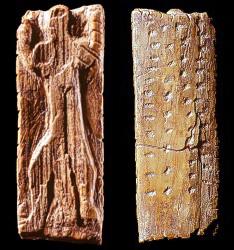
Fig.
1. Small ivory plate found in the Geißenklösterle Cave in the Ach Valley
of southern Germany, thought to show the figure of Orion in his role as the sky
hunter.
Orion in the Neolithic Age
The Ach Valley plate seems to demonstrate that interest in the Orion constellation began at a very early stage in human development, and thus it probably continued to remain important in the ancient mindset through till Neolithic times. This is when our ancestors gave up being hunters and foragers and settled down to become farmers and pastoralists, sometime around ca. 9000 BC. For instance, in Egypt's Western Desert, at the site of a dry lake known as Nabta Playa, an 7,000-year-old megalithic structure was built to incorporate very specific astronomical alignments featuring the Orion constellation.
During the epoch of its construction, ca. 4950 BC, an observer standing inside Nabta Playa's main "calendar" circle of standing stones could have watched Orion's "belt" stars rise in line with distantly placed stone slabs erected specifically for this purpose. Their presence argues strongly that the Neolithic farmers who built this astronomical observatory, next to what was once a savannah-like oasis, were acutely aware that over time stars change their rising and setting positions due to the effects of precession. This is the slow wobble of the earth's axis across a cycle of approximately 26,000 years. It is a surmise confirmed in the knowledge that when one outlying stone ceased to line up with the rising of a star, another would take its place, indicating an unfaltering interest in the stars of Orion across a very long period indeed.
The
Far Strider
Much later among the dynastic Egyptians Orion was known as Sah, the "toe-star," and later Sahu, the "toe stars." It was an appellation reflecting the fact that one of its stars, Rigel (Beta Orionis), sticks out in front of the other stars, as if it is leading Orion across the southern sky (Legon, 1995), hence the alternative rendering of Sah, or Sahu, as the "Far Strider" (see fig. 2). The three belt stars of Orion combine to point backwards to where on the horizon Sirius (Alpha Canis Major), the brightest star in the night sky, rises about one hour after Orion, emphasizing the relationship between these two very important asterisms (that is, Orion and Canis Major, the great dog).
Orion as Sahu, the Far Strider, also became the leader of a group of 36 stars and constellations known as the baku, or decans, used by the ancient Egyptians as celestial timekeepers across the calendar year.
Yet it is in its role as a personification of Osiris, god of death and the underworld, that Orion played its most far-reaching role in ancient Egypt, a subject elevated to prominence in February 1994 with the publication of a compelling and highly controversial book entitled The Orion Mystery.
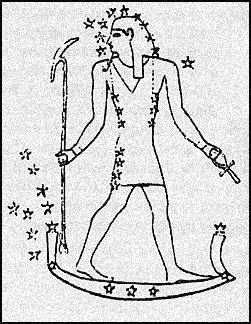
Fig.
2. Orion as Sahu, the Far Strider, leader of the 36 baku, or decan stars.
Mirroring the Gods
Written by Belgium-born engineer Robert Bauval and esoteric writer Adrian Gilbert, The Orion Mystery tells the story of how when in Saudi Arabia working with a petroleum company Bauval was out in the desert watching the stars one night. A friend, whose eyes had become fixed on the unmistakable sight of the Orion constellation, observed that the three stars making up the belt of Orion were very slightly misaligned. One of the stars, the middle one, Alnilam, seemed offset slightly from the other two in a manner that Bauval recognized as mimicking the exact geographical relationship of the Giza Pyramids - those of Khufu, Khafre and Menkaure - when viewed from above.
As above, so below. It was a simple axiom, voiced in the hermetic writings of Graeco-Roman Egypt, that helped convince Bauval to look into the matter further. So he examined the astronomical relationship between the belts stars of Orion and the stellar-based funerary religion of the ancient Egyptians and made some stunning discoveries. According to the Pyramid Texts, a remarkable body of funerary literature inscribed on the interior walls of pyramids from around 2350 BC onwards, it was to Sah, i.e. the Orion constellation, that the soul of the deceased king would ascend towards in order to reach an afterlife located somewhere in the vicinity of the circumpolar stars. These are the stars seen to revolve around the northern celestial pole, the turning point of the heavens. Some of them never set, while others set only briefly before rising again into the night sky.
The Orion Mystery proposed that the Giza Pyramids were built to ensure that the deceased king accessed a star portal corresponding with the astronomical coordinates of the Orion constellation. Reaching here permitted the soul entry to a sky world seen as the location of the afterlife. Backing up this startling theory was the fact that independent evidence showed that the Great Pyramid was built to target the Orion constellation, ca. 2500 BC.
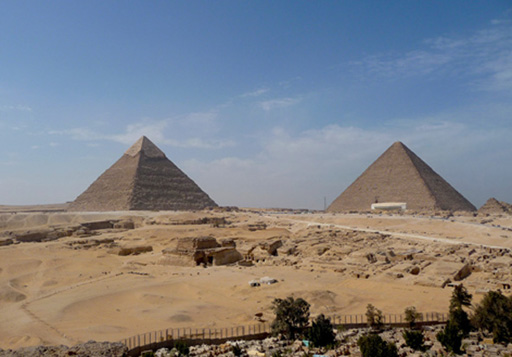
Fig.
3. The Great Pyramid (right) and Second Pyramid at Giza.
Passage to the Stars
The King's Chamber inside the Great Pyramid has two small openings, both rectangular in shape, one in the north wall and the other opposite in the south wall. Each penetrates horizontally the solid interior of the pyramid, built using hundreds of thousands of limestone blocks weighing between one and two tonnes a piece. They then climb at an angle due north and due south respectively, before coming close to exiting the pyramid's corresponding exterior faces. Two similar "air shafts" exist in the Queen's Chamber positioned directly beneath the King's Chamber. These also were found to climb at angles within the monument's superstructure toward the exterior walls of the pyramid.
Exactly what these rectangular air shafts represent remains a mystery to Egyptologists. Their best explanation is that they allowed air to circulate inside the structure during construction, or that they served some symbolic or astral function. In other words, they perhaps acted as spirit holes, enabling the soul of the pharaoh to exit the pyramid following the interment of the body. It was probably this last theory that in the 1960s helped inspire Egyptologist Alexander Badawy, working alongside American astronomer Virginia Trimble, to more closely examine the angles of ascent of the Great Pyramid's air shafts. They wanted to see whether they targeted any prominent stars crossing the meridian, the imaginary north-south line that divides the sky from horizon to horizon, during the epoch of their construction.
What Badawy and Trimble achieved was quite phenomenal. Without the aid of computers, they determined that around 2500 BC - when Khufu, the builder of the Great Pyramid, is thought to have reigned - the southern air shaft of the King's Chamber, which climbs at an angle of approximately 45 degrees, targeted Al Nitak, Orion's left-hand belt star, as it transited, or culminated its ascent, on the meridian each night (Badawy, 1964). They determined also that the northern air shaft in the King's Chamber targeted the star Thuban (Alpha Draconis) in the constellation of Draco, the dragon, as it too crossed the meridian at its highest point each night. Just 400 years earlier Thuban had been Pole Star. Yet by 2500 BC it had drifted some distance away from the northern celestial pole, due to the effects of precession, hence its nightly synchronization with the northern air shaft of the King's Chamber.
Much later Robert Bauval was able to determine that the southern shaft in the Queen's Chamber - inside which a small stone "door" was found in 1993 - targeted the bright star Sirius at its culmination on the meridian. In a similar manner, the northern shaft in the Queen's Chamber was found to target Kochab (Beta Ursae Minoris), a star in Ursa Minor, the little bear, which came close to being a Pole Star during the Pyramid Age.
Age
of the Gods
These findings in connection with the Great Pyramid's air shafts are hardly likely to be without meaning. They suggest that the stars in question were singled out as targets for the soul of the deceased in the afterlife. This fact alone added weight to what quickly became known as the Orion Correlation Theory (OCT). Yet Bauval went further, proposing that the Giza pyramid field - clearly built during the age of pharaohs, ca. 2500 BC - formed part of a grand design reflecting a mythical age of the gods known as zep tepi, the First Time, a concept believed in emphatically by the ancient Egyptians.
According to foundation texts such as the remarkable Edfu building texts recorded on the walls of the Temple of Horus at Edfu in southern Egypt, a group of mythical beings known as the Most Ancient Ones, or Eldest Ones, created the first primeval mounds and sacred enclosures at the time of zep tepi, only for everything to be wiped out during a cataclysm involving a period of darkness, a sudden flood, and the appearance in the sky of a dreadful omen called the Enemy Snake, or Great Leaping One (Reymond, 1969).
Thereafter more mythical beings turn up and resurrect the ghosts of the Most Ancient Ones, at the same time rebuilding the sacred enclosures, and erecting the first built structures. These included the first ever temple, which thereafter became the role model for the design of all subsequent temples built in ancient Egypt. Among this second wave of mythical beings were the neteru-gods, such as Osiris, Isis, Set, Horus and Thoth. They rule Egypt for thousands of years, their place eventually being taken by a race of semi-mythical origin known as the Shemsu-hor, the Followers of Horus, after which come the first mortal kings.
As to when zep tepi might have occurred, the various ancient Egyptian canons or king lists remaining in existence today vary, although one often thought to preserve the actual timeframe of the gods is the Royal Canon of Turin. This states that the gods reigned for over 8,000 years prior to the age of the first pharaoh Menes, who is thought to have taken the throne sometime around 3100 BC. Zep tepi as the age of the gods was thus thought to correspond with a timeframe roughly corresponding with the end of the last Ice Age, ca. 9,500-11,000 BC.
It was during this time, starting around ca. 10,900 BC and continuing in some manner for several hundred years afterwards, that the world was brought to its knees by a global cataclysm. This is likely to have been caused by fragments of a disintegrating comet (the Enemy Snake of the Edfu Building Text?) that hit the earth, causing immense devastation (including fire, flood and a long period of darkness) and triggering also a mini ice age known as the Younger Dryas event, which lasted through until around 9600 BC (see, for instance, Firestone, et al, 2006 & 2007).
Fire From the Sky
This cataclysm not only echoes the extraordinary account offered by the Edfu building texts, but also ancient Egyptian stories which tell of how the sun-god Re ordered the goddess Hathor, in her guise as the terrifying lioness-headed goddess Sekhmet, to destroy the human race. This she attempts to do with a reign of fire, which is stopped only when the other gods intervene and persuade Re to cover the earth with an intoxicating brew (an all-encompassing flood?) that Hathor consumes, causing her to fall asleep and forget what she is meant to be doing, an act that saves the human race from almost certain annihilation (see fig. 4).
It is only within the past ten years that pioneers of this subject, such as Richard B. Firestone of the Lawrence Berkeley National Laboratory, have been able to convince a sceptical world that these terrifying events really did take place in relatively recent geological history. However, back in the mid 1990s advocating such a disaster scenario was primarily the domain of alternative history writers like myself, who were not afraid to voice their opinions regarding this terrifying vision of the past (see, for instance, Collins, 1996).
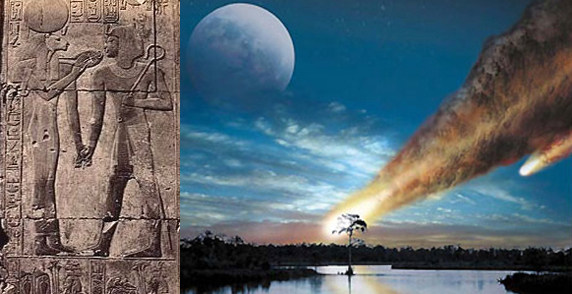
Fig.
4. Hathor in her guise as Sekhmet (left) caused a terrifying reign of fire that
very nearly destroyed the human race. Was this a memory of the Younger Dryas Boundary
impact event of 10,900 BC?
Turning Back Time
The Orion Correlation Theory supposed that the Giza Pyramids were built to mimic the astronomical positions of the belt stars of Orion as seen from the ground. However, the manner in which the general alignment of the three pyramids was offset at an angle of approximately 45º west of true north did not seem to reflect the angle of inclination of the belt stars as they crossed the meridian at their culmination in 2500 BC. The Pyramids were clearly out of kilter with their celestial counterparts.
As
Robert Bauval believed that locked into the grand design of the Giza monuments
was a memory of zep tepi, the age of the gods, he wondered whether the
match between the Giza Pyramids and the Orion belt stars reflected the skies not
during the epoch of their construction, ca. 2500 BC, but during this much earlier
epoch of human history.
Using
a computer sky program to look at the skies over Giza in the millennia prior to
the Pyramid Age Bauval was able to determine that the angle from true north created
by the general alignment of the Giza Pyramids matched exactly the angle adopted
by the Orion belt stars as they crossed the meridian in 10,450 BC. This is the
date cited in The Orion Mystery, although in subsequent publications it was rounded
up to 10,500 BC, which is the date I shall adopt in this article.
This shift in the positioning of Orion's belt stars as it crossed the meridian is due to the process of precession, which in addition to altering a star's rising and setting position against the local horizon alters the height and angle of inclination that a star or constellation crosses the meridian. Orion, so Bauval discovered, reached its nadir, the lowest point in its 26,000-year cycle, right around 10,500 BC, his proposed date for zep tepi. Since that time Orion has been gradually climbing back upwards, reaching its highest point in the night sky during this modern era. For Bauval all this seemed beyond coincidence, convincing him that the ancient Egyptians built the Pyramids at Giza to reflect the skies as they appeared when Orion was at its nadir, the lowest point in its precessional cycle around 10,500 BC.
Something else that Bauval noticed for the date 10,500 BC was the fact that from the perspective of Giza the Milky Way rose up into the night sky in line with the north-south flowing River Nile. Back then the Nile would have passed much closer to the eastern edge of the plateau. Thus the Milky Way, close to which the Orion constellation is situated, might have been seen as a celestial extension of the Nile river. Merging the two together would have seemed as if the stars of Orion were reached through some kind of symbolic journey along the Nile, its waters eventually transforming into its celestial counterpart, the Milky Way, or Winding Waterway as it is called in the Pyramid Texts (see fig. 5).
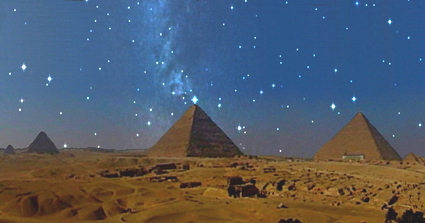
Fig.
5. The Milky Way sets over the Second Pyramid during the Pyramid Age, c. 2500
BC (Pic credit: Rodney Hale).
The Sphinx Revelation
Compounding the issue regarding the apparent interest of the ancient Egyptians in the concept of zep tepi were the findings of Boston University geologist Dr Robert Schoch. In 1992 he wrote that the Great Sphinx, the monumental carving of a recumbent lion with human head and nemes-headdress located at the eastern edge of the Giza pyramid field, was thousands of years older than had previously been surmised (Schoch, 1992).
Having been invited to examine the Sphinx in the company of ancient mysteries writer and self-proclaimed "maverick archaeologist" John Anthony West, author of thought-provoking books such as Serpent in the Sky (1979), Schoch examined the erosion patterns on the inner walls of the rectangular enclosure out of which the Sphinx had been carved from the limestone bedrock, and also those on the body of the Sphinx itself (see fig. 6). He concluded that neither wind nor chemical action were responsible for this erosion. In his opinion as a geologist, the deep, undulating, horizontal dips, broken in places by deeply-cut vertical incisions seen not only on the Sphinx but in particular on its surrounding walls, were the result of water erosion caused by rain precipitation across a very long period indeed.
Rain
in the Sahara
As the Sphinx has spent much of its life covered up to its neck in sand, blown in from the south by the fierce Saharan winds, it was Schoch's view that the heavy rains necessary to have caused the erosion seen today must have occurred prior to the desiccation of the Sahara, which most likely began as early as 4000-3000 BC, and continued through until the age of the pharaohs. The last time that sufficient rain had fallen in the Nile Valley to create the type of water runoff seen on the Sphinx and Sphinx enclosure, Schoch estimated, was between 9,000 and 7,300 years ago. At this time there had been prolonged periods of rain, resulting in a profusion of vegetation growth. This in turn enabled the establishment of human settlements throughout the Sahara, leading to the introduction of sheep and goat domestication. Even earlier, between 10,500 and 9,000 years ago, monsoon rains had swept through the Sahara, transforming the region into a habitable zone, allowing those human populations existing within reach of the Nile Valley to settle here for the first time in several thousand years (Carey, 2006).
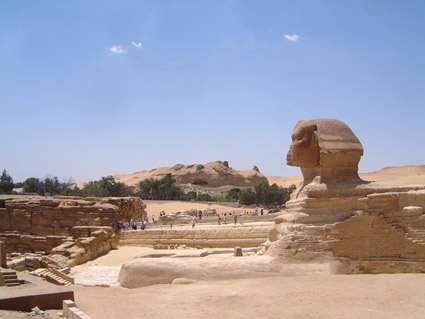
Fig.
6. The Great Sphinx on the eastern edge of the plateau at Giza.
In this knowledge, there was every reason to assume that the Sphinx could have existed when the Sahara was still a green and fertile region. If so, then it must have been carved thousands of years earlier than conventional thinking, which insists that the leonine monument was constructed during the reign of the pharaoh Khafre, the builder of the Second Pyramid, ca. 2450 BC. In the opinion of Egyptologists, it formed part of Khafre's funerary complex, which included a causeway that ran from the pyramid down past the Sphinx to a quay once linked via canals to the nearby Nile.
Schoch, however, as an academic, was cautious not to go too far with his theory. He proposed that the Sphinx was perhaps carved sometime between 5000 BC and 7000 BC (Schoch, 1994). His colleague John Anthony West, on the other hand, was prepared to push back the date even further. In his opinion the Sphinx was carved sometime around 10,500 BC ("Mystery of the Sphinx" NBC documentary, 1993), the same timeframe reflected in the design and layout of the Giza monuments according to the Orion Correlation Theory.
Equinox
of the Gods
In later books, such as Keeper of Genesis (1995, published in the USA as The Message of the Sphinx, 1997), co-written with bestselling writer and journalist Graham Hancock, an important new element was added to the Orion Correlation Theory. The Sphinx sits on the edge of the plateau at Giza, its eyes gazing out toward the eastern horizon where the sun rises at the time of the equinoxes each year. Today the equinoctial sun rises in the constellation of Pisces, the fish. Yet due to the effects of precession the sign in which the sun rises changes across the millennia. Very soon the stars of Pisces will gave way to those of Aquarius, the water carrier, bringing forth the much anticipated age of Aquarius.
Back in the Pyramid Age the equinoctial sun rose in the constellation of Taurus, the bull. Turning the clocks back still further we find that in 10,500 BC, the age of the Sphinx according to John Anthony West, as well as the most likely date of zep tepi according to the Orion Correlation Theory, it was the stars of Leo, the cosmic lion, that were seen low in the eastern sky immediately prior to the first light of dawn. This meant that if the Sphinx did belong to the equinoctial age of Leo, ca. 11,000-8800 BC, and not to that of Taurus, ca. 2500 BC, then it must once have gazed eastwards at its celestial counterpart in the pre-dawn light of the spring equinox. If so, then this was powerful confirmation not only of the ancient Egyptians' apparent obsession with zep tepi, the First Time, but also of the Orion Correlation Theory itself.
Revelations
of Our Time
Whatever the reality of these observations, they were profound revelations that have changed forever our perception of the ancient Egyptian mindset. They paint a different picture also of the motivations behind the construction of the Giza monuments, most notably the three main pyramids and Great Sphinx. Not only did it seem likely that the Pyramid Builders constructed their monuments to synchronize with the astronomical positions of Orion, Leo and the Milky Way, but they did this to reflect the skies during the age of zep tepi, the First Time, 10,500 BC. As we have seen, it is a date that corresponds pretty well with an earth-shattering cataclysm, which science refers to today as the Younger Dryas Boundary (YDB) impact event, as well as the proposed true age of the Great Sphinx. The sheer potency of these extraordinary ideas was so strong that once in the public domain they would be very difficult to come back from, ever. That said, Orion was about to get a rival it had not bargained for in the form of Cygnus, the celestial bird or swan, known also as the Northern Cross.
Dual
of the Stars
It was one night in early January 2005 that chartered engineer Rodney Hale - who had been examining claims of astronomical alignments at prehistoric sites (the subject of archaeo-astronomy) for over a decade - found himself unable to sleep. Passing the time, he wondered whether the Cygnus constellation could have been important in Ancient Egypt. It was a casual thought inspired by news that the current author had discovered compelling evidence that Cygnus had been seen as a place of first creation, as well as the destination of the soul in death, among various ancient cultures worldwide (see Collins, 2006 & 2014).
Hale began thinking about the Pyramids of Giza, and the Orion Correlation Theory. He had become fascinated by these ideas following the publication of The Orion Mystery in 1994, and had decided to check out a few facts for himself. One of the book's main proposals, that the three Orion belt stars matched perfectly the geographical relationship of the three Giza Pyramids, had been demonstrated by placing an overhead image of the Giza Pyramids next to a photograph showing the three belt stars of Orion. The photo had been overexposed in order that the size of the stars matched the size of the pyramids (a normal photographic image of the belt stars would show them as small dots when compared against the relative size of the three pyramids when viewed from above).
So in order to better understand the Orion Correlation Theory, Hale superimposed a regular photograph of the Orion belt stars over a plan of the Giza Pyramids. The results were disappointing, for when the first star Al Nitak was matched with the peak of the Great Pyramid and the second star, Alnilam, was synchronised with that of the Second Pyramid, the third star, Mintaka, fell beyond the western limits of the Third Pyramid (see fig. 7).
Adjusting the positions of the stars for the First and Second Pyramids did not help rectify the situation, leaving Hale frustrated by the mismatch, particularly as the Pyramid Builders had taken such care to align the four sides of the Great Pyramid to true north (they are, on average, within three minutes of a degree of absolute precision). Why would the ancient Egyptians have made such a big mistake when attempting to replicate the astronomical positions of the Orion belt stars? It just did not make sense.
Thinking
the Unthinkable
As an engineer, it was a realization that troubled Hale. Such minor quibbles had, however, not dampened his interest in the Orion Correlation Theory. Yet now he was thinking the unthinkable. He wondered whether three key stars in Cygnus - Gienah, Sadr and Delta Cygni - which form the "wings" of the celestial bird, might better match the geographical relationship of the three pyramid peaks at Giza. Just like the Orion belt stars, the Cygnus wing stars display a notable kink in their spatial arrangement caused by the slight misalignment of the middle star, Sadr. This made the prospect of matching the pyramid peaks against the Cygnus wing stars an exciting one. Indeed, the more Hale thought about it, the more he felt that the match would be close indeed.
Getting up that morning he quickly obtained a suitable image of the Cygnus constellation and used computer technology to compare the astronomical positions of its three wing stars with the pyramid peaks. They were a perfect match. What is more, the ground-sky correlation reflected the manner in which the stars would be seen to set on the north-northwestern horizon during the Pyramid Age, a perfectly natural selection for a ground-sky correlation (see fig. 8 with proper motion and refraction taken into account). The bigger question now was whether this discovery was meaningful, or simply a happy coincidence. Clearly, the Orion constellation had been important in ancient Egypt, but what about Cygnus? Had that been important too? More pertinently, what did this mean for the Orion Correlation Theory, which relied heavily on a similar ground-sky overlay? Surely, both star groups could not be associated with the same set of pyramids, implying that only one star group was the correct one. But which was it? Orion or Cygnus?
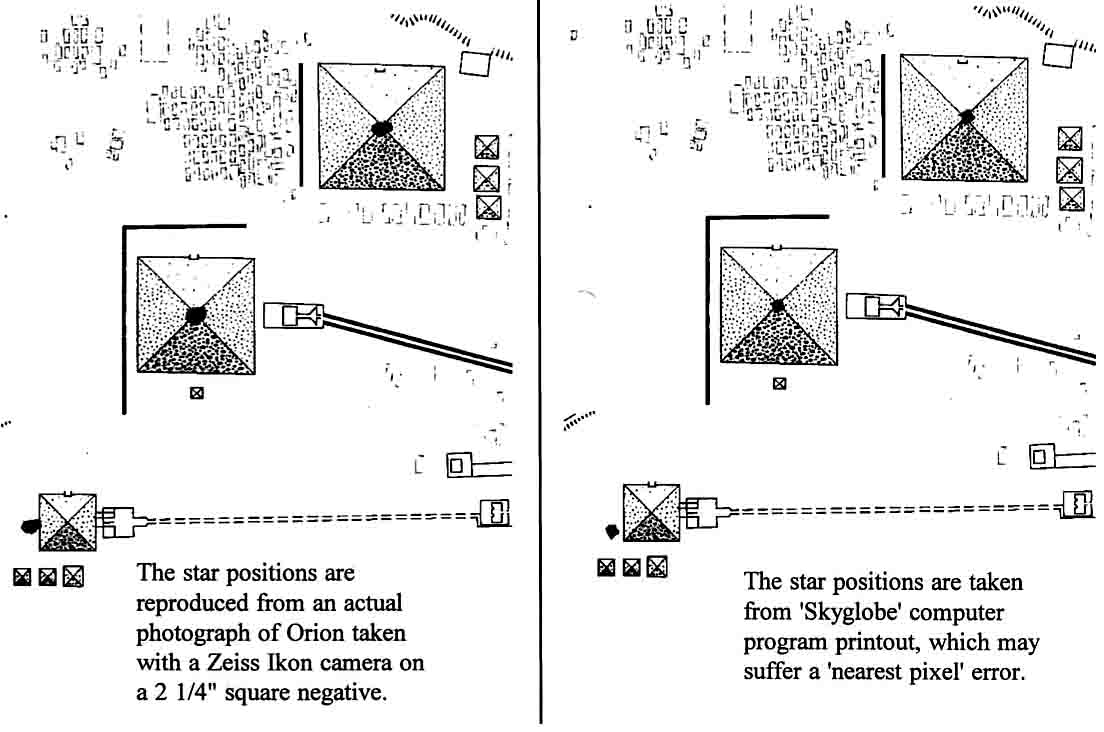
Fig.
7. Rodney Hale's original attempts at overlaying the Orion belt stars with the
peaks of the three Giza Pyramids. Note that the star Mintaka falls well beyond
the western limits of the Third Pyramid (Pic credit: Rodney Hale).
It was later that same day, Monday, January 3rd, 2005, that the present author received an email from Rodney Hale outlining the perfect ground-sky match between the Cygnus wing stars and Giza Pyramids. The accuracy was undeniable, although I also realized just how explosive this discovery was, and how troubling it would be to make public. I was at the time writing a book that explored Cygnus's role in ancient cosmologies, and had not anticipated this type of revelation. Citing Hale's findings would, quite clearly, bring me into conflict not only with staunch supporters of the Orion Correlation Theory, but also with Robert Bauval, a friend and colleague whom I had known and supported for over a decade.
Obviously, I knew that the ground-sky match between the Orion belt stars and the Giza Pyramids was not good. This Hale had pointed out to me some years earlier. My greater concern, however, was not so much the exactness of the Orion correlation, but whether or not it was meaningful in the first place. Had the ancient Egyptians really built the Giza Pyramids to reflect the Orion constellation as it appeared in the skies in 10,500 BC, a full 8,000 years before the construction of the monuments themselves?
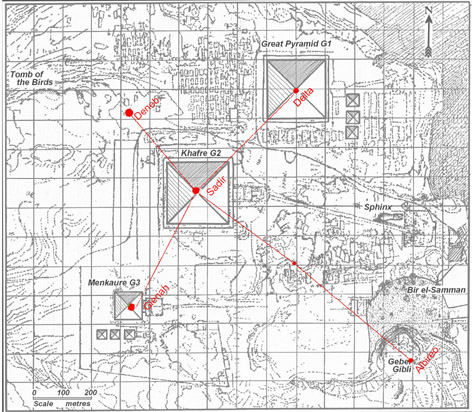
Fig.
8. The best match for the Cygnus wing stars and the three Giza Pyramids taking
into account the correct proper motion for the star Gienah and the slight adjustment
for refraction (which really only affects the position of Gienah - shown as the
gap between the end of the line and the star). The other key stars are marked
only for comparison with the whole Cygnus star group. (pic: Rodney Hale/Yuri Leitch).
Egypt's Epi-paleolithic Culture
There is little question that this fertile region of the Nile was occupied prior to the rise of dynastic Egypt, due to the presence of Neolithic settlement sites in the South Cairo area as early as 5000-4100 BC (Hoffman, 1977). There is also evidence of Epi-paleolithic (that is terminal Paleolithic, or early Mesolithic) peoples living in the area of Heliopolis and Abbasiya, northwest of modern Cairo (Hayes, 1965, 62-65). The exact age of these settlements remains unclear, although their very specific style of stone tools prompted American Egyptologist William C. Hayes (1903-63) to conclude that they belonged to the "last surviving stages of the Paleolithic in northern Egypt." (Hayes, 1965, 64). The significance of this realisation is that Heliopolis, the Greek name for the Egyptian cult center of Annu (the Biblical city of On), went on to become the primary cult centre of the creator god Atum during dynastic times. Had something similar been going on at Giza prior to the age of the pharoahs? Had it also played host to an Epi-paleolithic culture capable of carving the Sphinx monument?
Epi-paleolithic stone tools have occasionally been found on the Giza pyramid field itself, some in a style known as the Mousterian, or Levallois, which originated during a much earlier epoch of humankind. In addition to this, stone tools from the Lower and Middle Paleolithic, ca. 200,000-40,000 years ago, have been found on the desert surface to the north of the Giza Pyramids (Hayes, 1965, 45, 56).
Alternative
Answers
All this might be true, yet the argument that the Sphinx dates to 10,500 BC, or even 7000-5000 BC, remains a matter of speculation. What is more, it is now known that far more rain fell during dynastic times than anyone had previously imagined, while more conservative estimates suggest that even if the Sphinx does belong to an earlier epoch of activity at Giza then it might be just a few hundred years older than is currently accepted by Egyptologists. British geologist Colin Reader has proposed that the weathering effects on the Sphinx enclosure were caused by rain precipitation immediately before the age of the pharaohs Khufu, Khafre and Menkaure, the builders of the three Giza Pyramids (Reader, 2002).
Reader's own proposal, based on suggestions given originally by this current author, is that the Sphinx was built by a king named Neb-ra (also written Ra-neb), who reigned during ancient Egypt's Second Dynasty, ca. 2850 BC (private communication between Colin Reader and the author). Like the later Pyramid Builders, Neb-ra was a devotee of the cult of Re (or Ra), the sun-god, and entered into a number of legendary building projects during his life time. Since it is known that members of his royal dynasty were buried in tombs to the south of the present pyramid field at Giza, he becomes a realistic candidate for the construction of the Sphinx. Thereafter the leonine monument was incorporated into the funerary complex of Khafre, who was himself a revivalist of the cult of Re, the sun-god. Very possibly the Sphinx started out as the statue of a seated lion guarding the edge of the plateau, and was recarved into the likeness of a Sphinx with anthropomorphic features during the reign of Khafre.
Of course, Colin Reader could always be wrong in his assessment of the age of the Sphinx. Yet equally there is no guarantee that Schoch is right either, or West, or the conventional Egyptologists, who continue to insist that the Sphinx was constructed either by Khafre or one of his immediate predeccessors, either Khufu or his son, Djedfre, Khafre's older brother. In all honesty, we simply don't know when the Sphinx was carved. It could have been during the age of Leo, or it might have been much later indeed.
Angle
of Inclination Checked
Over and above all this are the problems in accepting the greater implications of the Orion Correlation Theory. For instance, according to Robert Bauval the changing angle of inclination of the Orion constellation across the 26,000-year precessional cycle allowed him to calculate the precise date for zep tepi based on the angle at which the Giza Pyramids were offset from true north. This he determined to be 10,450 BC (later rounded up to 10,500 BC). But was this correct? Was it really the date most associated with the age of the gods in ancient Egyptian tradition? Was this even what the Pyramid Builders intended when they chose the geographical locations of the three major Pyramids at Giza?
Rodney Hale checked the angle of inclination of Orion's belt stars as they crossed the meridian during the epoch in question to see when exactly they matched the general alignment of the three Giza Pyramids, which, using the peaks of the Great Pyramid and Second Pyramid, is approximately 45 degrees west of north. This simple exercise showed that there is no synchronization between the Orion belt stars and the three Pyramids of Giza for the dates 10,450 BC or 10,500 BC. Indeed, to create an exact match between the Giza Pyramids and the angle of inclination of the Orion belt stars you have to go back to 11,800 BC, not 10,500 BC (see fig. 9). It is important also to point out that in 11,800 BC the Milky Way rose into the night sky at a much steeper angle than it did in 10,500 BC, making it a far better match for Bauval's proposed ground-sky synchronization with the River Nile.
So
does this fresh look at the relationship between the Orion belt stars and the
Giza pyramid field provide a new date for zep tepi, the First Time? Should
it always have been 11,800 BC, when both stars and pyramids were truly synchronized
together? Perhaps, although changing the date of zep tepi brings its own
inherent problems. A date of 11,800 BC is as much as 800 years before the commencement
of the age of Leo, which began around 11,000 BC and lasted for as much as 2,200
years. It was during this troublesome epoch that the Younger Dryas Boundary impact
event took place ca. 10,900 BC. This is something that might easily have been
seen as closing a prior golden age of humankind, perhaps one marked by the 2,000-year
warm period known as the Allerød interstadial, which occurred ca. 13,000-11,000
BC, that is immediately prior to the impact event.
The terrifying aftermath
of this global catastrophe might well have been taken as a new beginning for humankind,
one that would lead eventually to the flowering of agriculture at the time of
the Neolithic revolution, ca. 9000 BC, and through it the rise of our present
civilization. All this might have been seen to have happened during the astrological
age of Leo, ca. 11,000-8800 BC. So to find that a date of 11,800 BC is implied
by the synchronization between the Giza Pyramids and the Orion belt stars throws
the Orion Correlation Theory's connection with the age of Leo into jeopardy.
This we can see from the fact that if the Sphinx did ever gaze out at the stars of Leo as they rose ahead of the equinoctial sun, the belt stars of Orion did not cross the meridian during this same epoch at the angle created by the offset from true north of the Giza Pyramids. This ground-sky synchronization (if indeed it was intended to be part of the grand design at Giza) had occurred a full 1,300 years earlier, in 11,800 BC, removing any significance the age of Leo and the date 10,500 BC might have played with regards to the positioning of the Giza Pyramids. Clearly, these are troubling realizations that leave the Orion Correlation Theory on shaky ground indeed.
Whatever these findings imply, there seems little question that Orion was incredibly important to the funerary beliefs and practices of the Pyramid Builders. The Pyramid Texts identified Sah, the "toe star," as a gateway that enabled the soul of the deceased to enter the Milky Way, the Winding Way, where it continued its journey towards an eventual afterlife among the Imperishable Stars of the northern sky. It is a fact reflected perhaps in the manner that the southern air shaft of the King's Chamber targeted the Orion star Al Nitak as it crossed the meridian around 2500 BC. It might even have been that the other air shafts allowed access to the stars they also targeted; Thuban, in connection with the northern shaft of the King's Chamber, and Sirius and Kochab in connection with, respectively, the southern and northern shafts of the Queen's Chamber.
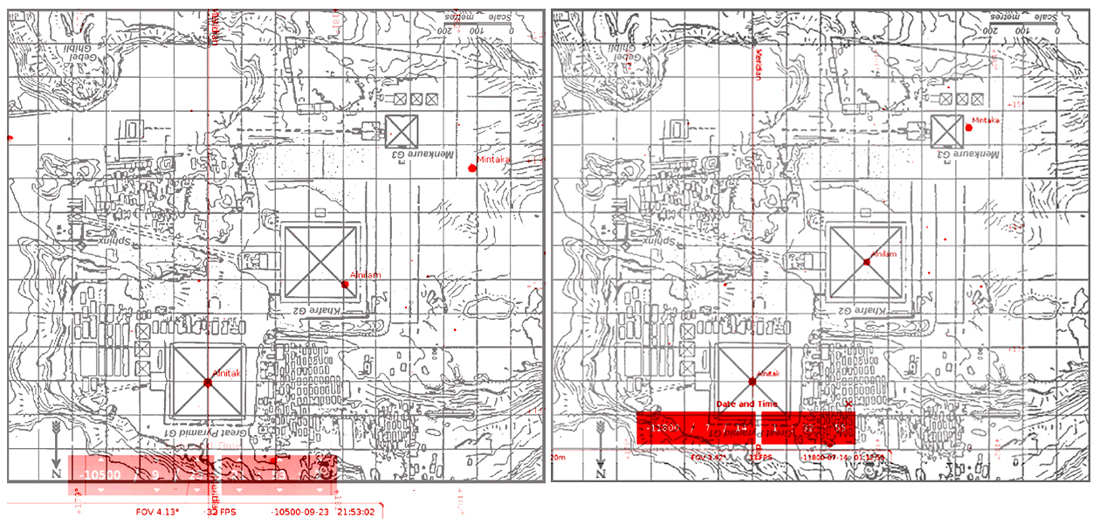
Fig.
9. Overlays of the Orion belt stars against the Giza Pyramids for the dates 10,500
BC (top) and 11,800 BC (bottom) using the peak of the Great Pyramid as the starting
point of the offset from true north. As we can see, the synchronization for 10,500
BC is extremely poor, with the best match occurring in 11,800 BC (Pic credits:
Rodney Hale/Yuri Leitch).
Rodney Hale and the author checked out the mean angle of ascent of the various air shafts in the Great Pyramid against the various stars they are supposed to target in 2500 BC, and we can confirm that three out of four of the claimed alignments are within a degree of accuracy, which seems acceptable (see fig. 10). Just one alignment falls outside of this 1º accuracy range, and this is the northern shaft of the Queen Chamber. It misses it proposed target, the star Kochab in Ursa Minor, by just over 1.5º degrees.
Yet despite these encouraging findings there are inherent problems in accepting the stellar roles played by the Great Pyramid's air shafts, for although they work pretty well for 2500 BC, they would all fall apart were it to be established that the Great Pyramid was constructed on any other date. Indeed, there is good reason to believe that the Great Pyramid is as least a century older than 2500 BC. A discarded meal of locusts left behind in a fire pit by a party visiting what has become known as Djedfre's "Water Mountain," a natural hill deep in the Libyan desert, during the reign of Djedfre, Khufu's son, has been radiocarbon dated to 2610 BC, while charcoal obtained from the same hearth has provided dates in the region of 2780 BC (Kuper and Förster, 2003).
Egyptologists advise caution when reviewing these early dates, as recalibrated dating evidence cannot be expected to correspond exactly with accepted historical chronology, which places the reigns of Djedfre and his father Khufu "between c 2604 and 2572 BC" (Kuper and Förster, 2003). So assuming that the Great Pyramid incorporates star alignments that work only for the date 2500 BC, before or after which they fail to work in synchronization, or simply disappear, is troubling indeed.
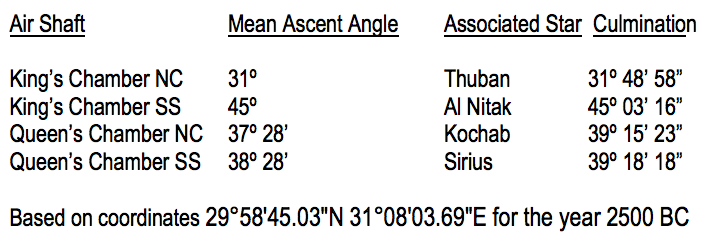
Fig. 10. The angle of the King's Chambers air shafts against the angles of the associated stars at their culmination on the meridian. All except Kochab's synchronization with the Queen's Chamber are within 1º of accuracy for the date 2500 BC.
Orion vs Cygnus
As to Cygnus's role in ancient Egypt. This was seriously questioned by Robert Bauval following the publication of the author's work The Cygnus Mystery in 2006, as was the book's claim that the three wing stars of Cygnus synchronized perfectly with the peaks of the three Giza Pyramids. All these queries were suitably addressed both at the time (see here and here), and also within the author's book Beneath the Pyramids (2009). In addition to this, a complete exegesis of the Pyramid Builders interest in Cygnus is offered in Giza's Cosmic Blueprint - Part 1: Is Cygnus the Key to Unlocking the Pyramid's Grand Unified Plan? (Collins, 2011a) and Giza's Cosmic Blueprint - Part 2: The Search for Egypt's Mound of Creation (Collins, 2011b).
These articles show conclusively that in the Pyramid Age Cygnus was seen as the cosmic womb of Nut, the sky goddess and mother of both Osiris and the sun-god Re. The Pyramid Texts make it clear that the tomb, sarcophagus and coffin were created in order that the deceased in his role as Re or Osiris was able to ascend to the womb of Nut, marked in the night sky by the Milky Way's Great Rift (see below), and the stars of Cygnus. Moreover, the pyramid, in its role as the primeval mound, was created to mimic the cosmic womb, or swollen belly, of the goddess, in order for the soul of the deceased to return to its place of beginning among the Imperishable Stars of the northern sky, including, of course, those of the Cygnus constellation. It was for these reasons, the current author argues, that the Giza Pyramids were laid out to reflect the astronomical positions of the Cygnus wing stars as they set each night on the north-northwestern horizon.
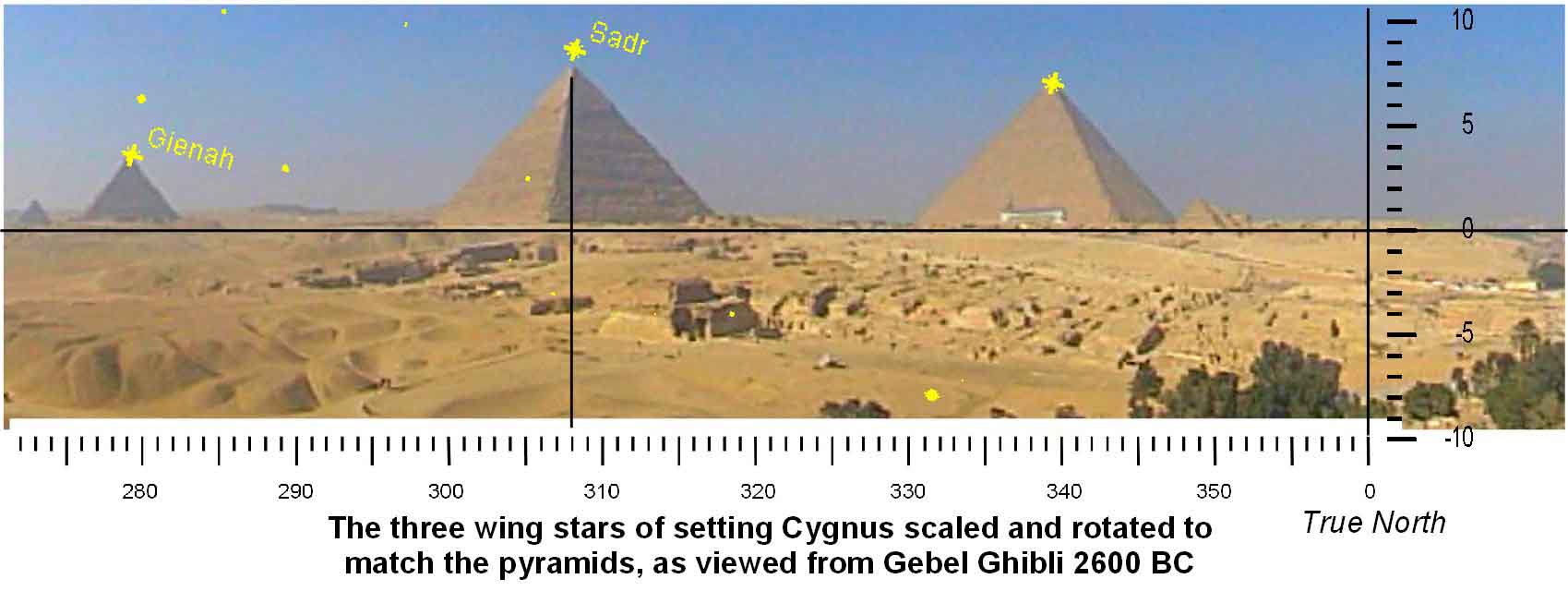
Fig.
11. The Cygnus wing stars matched with the peaks of the Giza Pyramids as seen
from the plateau's southern hill Gebel Gibli, very likely the pyramid field's
original survey point. An observer to the southeast of the plateau during the
Pyramid Age would have seen this spectacle for real - the three Cygnus wing stars
setting down, one by one, into their corresponding pyramids in the Cygnus-Giza
correlation (Pic credit: Andrew Collins/Rodney Hale).
Path of Souls
Elsewhere
in the world Cygnus and Orion play dual roles in the soul's journey into the afterlife.
For instance, the cosmic iconography of the Southeastern Ceremonial Complex (SECC),
formerly known as the Southern Death Cult, which thrived during the Mississippian
period, ca. AD 800-1500, was unquestionably a major influence on the funerary
beliefs and practices of many Native American tribes (see Gregory Little's book
Path
of Souls, 2014, for a full investigation of this topic. The book includes
contributions from the present author). For them the Milky Way was the Path of
Souls, along which the soul undertook a journey to reach the afterlife. Just two
asterisms emerge as central to the SECC's cosmic geography. One is the hand and
eye constellation, identified with the Orion constellation. This becomes the initial
entry point to the Milky Way, while the Cygnus star Deneb, personified as a birdman
named Brain Smasher, judges the soul as it approaches a fork or division in the
Path of Souls. This fork corresponds to the point where the Milky Way splits into
two separate streams due to the presence of stellar dust and debris in line with
the centre of the galactic plane. The dark central area between the two streams,
which begins in the region of the Cygnus star Deneb and continues down to the
area of Sagittarius and Scorpius, is known variously as the Great Rift, Dark Rift
or Cygnus Rift.
Brain Smasher addresses the soul of the deceased, determining
whether or not it is free of sin. If it is, then it can reach the sky world proper
via a log bridge, identified as the connecting arm of the Milky Way's Great Rift.
Thereafter the soul enters the realm of the celestial beings and is reunited with
its ancestral family.
The
only other constellation to feature heavily in the star myths of the SECC is Scorpius.
This is located just below the other arm of the Great Rift, which peters out just
before its reaches this star group. Many Native American tribes saw this asterism
as the Water Panther or Winged Dragon, which is how it appears in the decorative
art of the SECC. Very likely the gap between the end of the Great Rift's short
arm and the stars of Scorpius signified the void into which the unclean soul was
cast; its final destination being the underworld, or lower world, seen as located
below, or beyond, the line of the ecliptic, the sun's path, which crosses the
Milky Way at this point.
Most likely these combined cosmological ideas, which equally feature Orion and Cygnus, were present among the Adena and Hopewell cultures, ca. 1000 BC to AD 500, and had existed on the North American continent since the arrival of its first permanent inhabitants towards the end of the last Ice Age, ca. 25,000-15,000 BC. Originally perhaps Orion and Cygnus played a similar dual role in ancient Egypt, their point of connection being the Milky Way, the universal road or river along which the soul of the deceased travels to enter the afterlife.
It
would have been a similar story in other parts of the ancient world as well, Orion
and Cygnus working together as twin portals leading to the sky world. That said,
there can be just one victor when it comes to the synchronizing of key stars with
the geographical positions of the Giza Pyramids. Either they were built to reflect
the influence of Orion's belt stars - Al Nitak, Alnilam and Mintaka - or they
resonate the influence of Cygnus's wing stars: Delta Cygni, Sadr and Gienah. So
which is it? Orion or Cygnus? Are you an Orionite, a follower of the great hunter,
or a Cygnet, a child of the swan? All the necessary material you need to make
up your own mind is cited here.
Bibliography
Publication abbreviations: BF = Before Farming; DE = Discussions in Egyptology; EA = Egyptian Archaeology; JACF = Journal of the Ancient Chronology Forum; MIO = Mitteilungen des Instituts für Orientforschung (Berlin); PNAS = Proceedings of the National Academy of Sciences of the United States of America.
Badawy,
Alexander, "The Stellar Destiny of Pharaoh and the So-Called Air-Shafts of
Cheop's Pyramid," MIO 10 (1964), 189-206.
Bauval, Robert, and Adrian Gilbert.
The Orion Mystery. London: Heinemann, 1994.
Carey, Bjorn, "Sahara
Desert Was Once Lush and Populated," LiveScience, July 20, 2006, http://www.livescience.com/4180-sahara-desert-lush-populated.html
(accessed March 21, 2014).
Collins, Andrew. From the Ashes of Angels.
London: Penguin, 1996.
Collins, Andrew. The Cygnus Mystery. London:
Watkins, 2006.
Collins, Andrew. Beneath the Pyramids. Virginia Beach,
VA: 4th Dimension Press, 2009.
Collins, Andrew. "Giza's Cosmic Blueprint
- Part 1: Is Cygnus the Key to Unlocking the Pyramid's Grand Unified Plan?,"
2011a, http://www.andrewcollins.com/page/articles/cygnus_blueprint.htm.
Collins,
Andrew. "Giza's Cosmic Blueprint - Part 2: The Search for Egypt's Mound of
Creation," 2011b. http://www.andrewcollins.com/page/articles/cygnus_blueprint_2.htm.
Firestone,
Richard, Allen West, and Simon Warwick-Smith. The Cycle of Cosmic Catastrophes.
Rochester, VT.: Bear & Co, 2006.
Firestone, R. B., A. West, J. P. Kennett,
L. Becker, T. E. Bunch, Z. S. Revay, P. H. Schultz, et al. "Evidence for
an Extraterrestrial Impact 12,900 Years Ago That Contributed to the Megafaunal
Extinctions and the Younger Dryas Cooling." PNAS 104 (2007): 16016-21.
Hancock,
Graham, and Robert Bauval. Keeper of Genesis/The Message of the Sphinx.
London/New York, NY: Heinemann,1995/Crown,1997.
Hayes, William C. Most Ancient
Egypt. Chicago, IL/London: University of Chicago Press, 1965.
Hoffman,
Michael A. Egypt Before the Pharaohs. New York, NY: Alfred A. Knopf, 1979.
Kuper,
R. and F. Förster, F. 'Khufu's "mefat" expeditions into the Libyan
desert', EA 23 (2003), 25-8; 28.
Legon, J.A.R. "The Orion Correlation
and Air-Shaft Theories," DE 33 (1995), 45-56.
Little, Gregory, with foreword
and afterword by Andrew Collins. Path
of Souls: The Native American Death Journey.
Memphis, TN: Archetype Books, 2014.
Pettitt, P.B. "A Palaeolithic star
chart, or stars in our eyes?" BF 1:15 (2003), 1-2.
Reader, Colin. "Giza
Before the Fourth Dynasty," JACF 9 (2002), 5-21.
Reymond, E. A. E. The
Mythical Origin of the Egyptian Temple. Manchester: Manchester Univ. Press,
1969.
Schoch, R. M. "Redating the Great Sphinx of Giza," KMT:
A Modern Journal of Ancient Egypt 3:2 (Summer 1992), pp. 52-59, 66-70.
Schoch,
Robert M. "Response to James A. Harrell," KMT: A Modern Journal of
Ancient Egypt 5:2 (Summer 1994), 6-7.
West, John Anthony. Serpent in
the Sky. Scranton, PA: HarperCollins, 1979.
Whitehorse, Dr David. "'Oldest
star chart' found," BBC News, January 21, 2003. http://news.bbc.co.uk/1/hi/2679675.stm
(accessed March 22, 2014).
DVD
"Mystery of the Sphinx." NBC special, 1993.
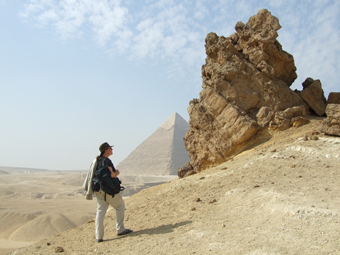
The
author on Gebel Gibli, Giza's southern hill,
with the Second Pyramid in the
background.
![]()